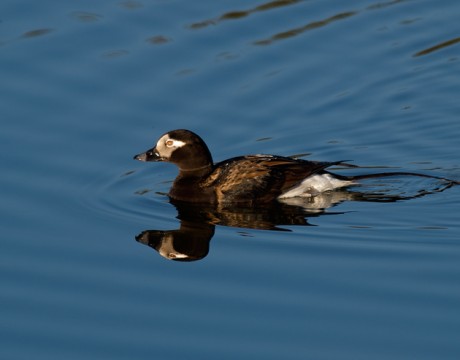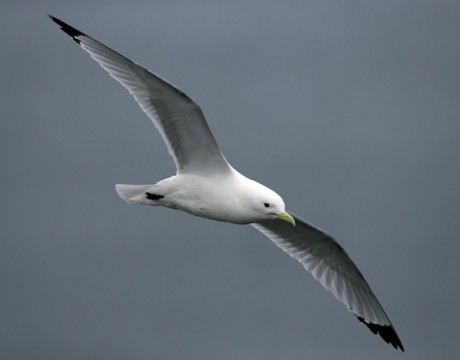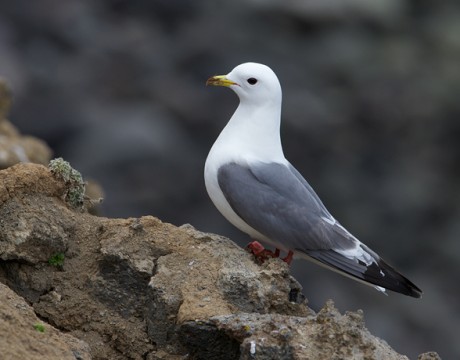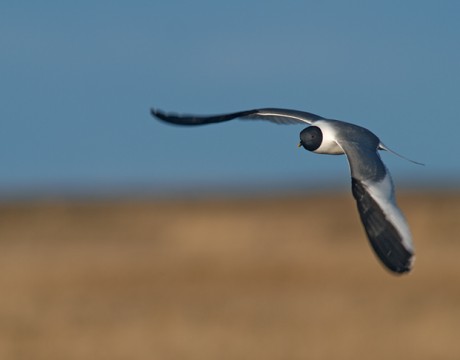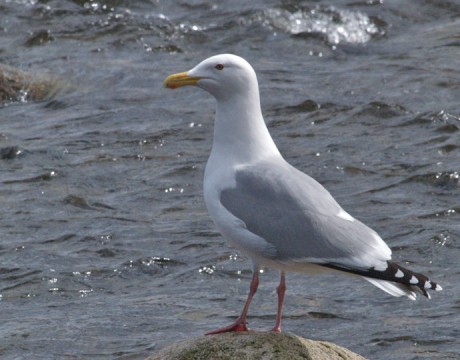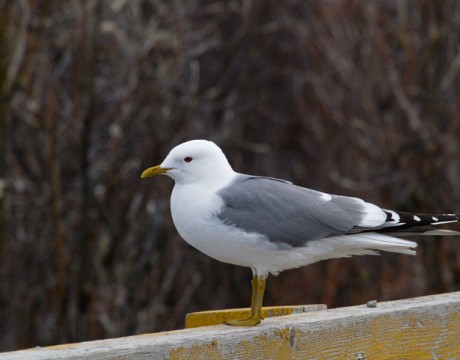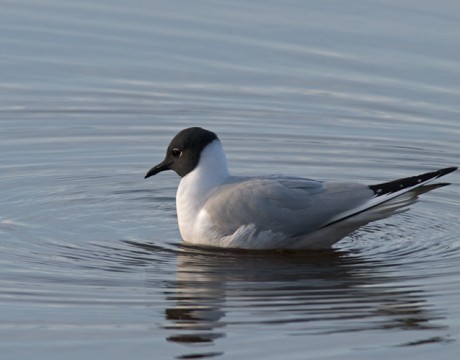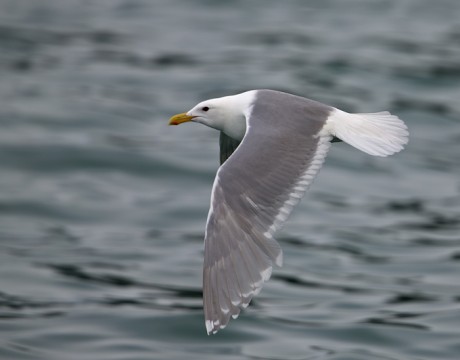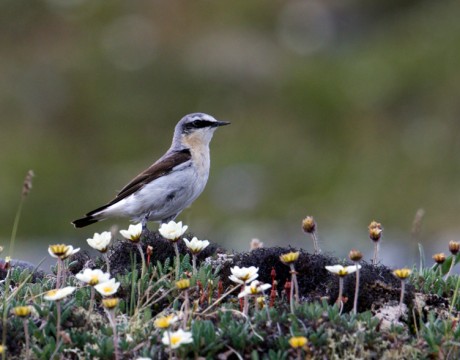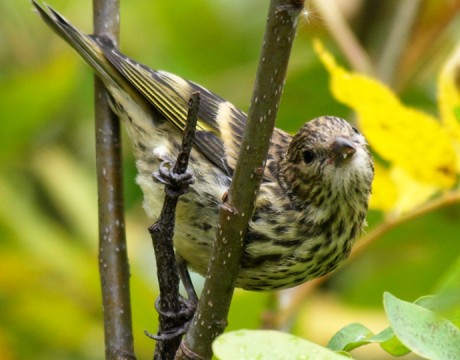Bird of the Week – Long-tailed Duck
WC has been accused of neglecting waterfowl in his selection of Birds of the Week. Ironically, WC is a graduate of the University of Oregon, a Duck – a Fighting Duck. So WC will post a few duck photos, honoring his alma mater and answering certain carping quacking critics. We’ll start with the Long-tailed Duck. Formerly known as Oldsquaw, the Long-tailed Duck spends most of its life at sea. In the winter, you can find rafts of thousands of Long-tailed Ducks off shore of Kodiak Island, so many that despite the distance you can hear the calls. Which does indeed sound…
Bird of the Week – Black-legged Kittiwake
A handsome, delicate-looking gull, the Black-legged Kittiwake breeds in southcentral and southwestern coastal Alaska. Generally a colonial breeder, some of the rookeries are immense. The species’ name probably comes from its call, which does sound very much like “kittiwake”. A small number of non-breeders can usually be found along the bridges on the easterly side of Valdez Arm. The lemon-yellow bill, jet blacklegs and black-tipped wings are reliable field marks for this species. For more bird photos, please visit Frozen Feather Images.
Bird of the Week – Red-legged Kittiwake
There are only a handful of places in the world where you can see this gull. The Red-legged Kittiwake is found in the Pribilof Islands, a few of the Aleutian Islands and parts of Siberia. A small, handsome gull with the signature bright red feet, it nests on St. Paul Island. This bird’s bill is dirty from hauling grass and mud 3/4ths of a mile to a nest on the steep, high cliffs known as Kittiwake Condos on the northwest corner of the island. It’s two miles uphill from where the guides park the van, but it’s worth the walk….
Bird of the Week – Sabine’s Gull
A much less common gull than the ones we’ve seen the last two weeks, the Sabine’s Gull is a very handsome species that breeds in Western and Northwestern Alaska. The species winters at sea in the Southern Hemisphere, flying to the coastal Arctic and Subarctic to breed. The striking white margins on the wings, the black hood, the red-rimmed eye and the yellow tip on a black bill make this an easy bird to recognize. Like most long-distance migrants, Sabine’s don’t build much of a nest, just some packed grass on a high spot on the tundra. Sabine’s Gull is…
Birds of the Week – American Herring Gull
The largest gull In Interior Alaska, slightly larger than the Glaucous-winged Gull, is the Herring Gull. This is a highly variable species, and ornithologists disagree on how many species and subspecies there are, and even what its name should be. A big gull with pink legs and a honking big bill, it has black first and second primaries with white “windows” and a white tail, making it easy to distinguish from the similarly-sized Glaucous-winged Gull. The Herring Gull is another four year gull, resulting in a truly bewildering series of plumage changes. The International Ornithological Union and the American Ornithological…
Bird of the Week – Mew Gull
By far the most common gull in Interior Alaska is the Mew Gull. And if you’ve been to Potter Marsh on the southeastern edge of Anchorage recently, you’ve seen flocks of them there, too. The Mew Gull is a three year gull, meaning there are 6-7 plumages to the mature, breeding adult you see here. In Interior Alaska, we only get adults and hatch years birds; first and second year birds wait to maturity before venturing this far north. The small, delicate bill, yellow legs and black primaries make this a pretty easy bird to identify. The yellow legs are…
Bird of the Week – Bonaparte’s Gull
A couple of folks asked what WC meant by saying gulls had lots of different plumages. We’ll use today’s bird, the Bonaparte’s Gull, to illustrate the point. Here’s an adult Bonaparte’s Gull in breeding plumage: Note the deep black hood extending to the back of the skull, the black bill and the pale grey back. If you could see the legs, they’re fire engine red. Then there’s this bird: This is the same species, except the adult is in non-breeding plumage. The head is white, except for a small black spot behind the ear; the bill is solid black. The…
Bird of the Week – Glaucous-winged Gull
WC is an unabashed Laridophile, a gull lover. And in coastal Alaska, one of the most common Alaska gulls is the Glaucous-winged Gull. The Glaucous-winged is a four-year gull, meaning it takes four years to reach maturity. Each year, each young bird goes through at least two different plumages, as do adults. So you have at least eight different-looking gulls, that are all Glaucous-winged. It can make gull identification a challenge. Adult breeding Glaucous-winged birds are fairly straightforward: a large gull, with no black in the wings or tail, and medium grey wings. Hard core birders also note the small…
Bird of the Week – Northern Wheatear
There is a bird that winters with elephants and giraffes, and summers with us in Alaska. The Northern Wheatear has one of the longest migration routes among the passerines, the small singing birds. The species breeds on rocky slopes like the White Mountains and Brooks Range in Alaska. Once the kids are fledged, it packs up and flies to Africa – yes, southeastern Africa – for the winter. 9,000 miles, each way. The bird weighs just 25 grams. It’s a privilege to photograph them. For more bird photos, please visit Frozen Feather Images.
Bird of the Week – Pine Siskin
Alaska is at the northerly limit of the range of the Pine Siskin. Even smaller than the Common Redpoll, it’s a member of finch family and a big fan of bird feeders. Pine Siskins are gregarious; you find them commonly in large flocks. The yellow in the primaries and heavily streaked breast, with the buffy wingbars, make this a pretty easy bird to recognize. For more bird photos, please visit Frozen Feather Images.





